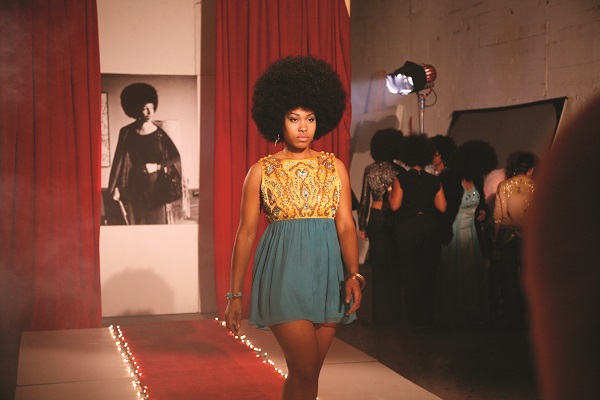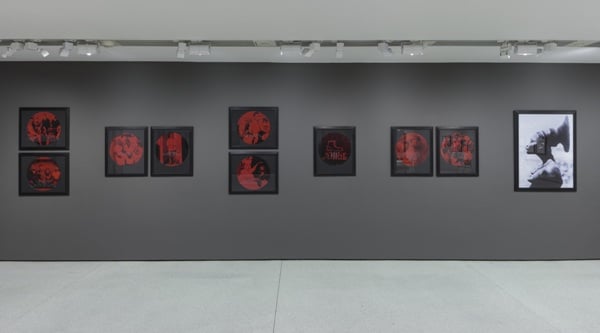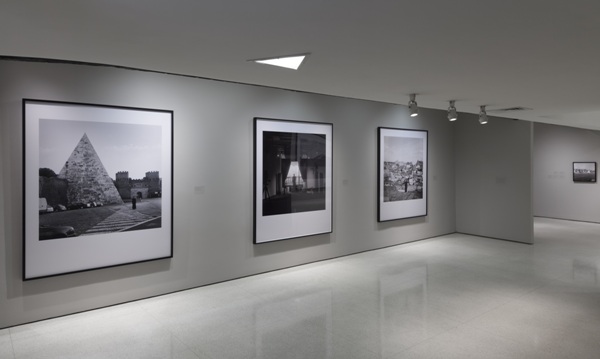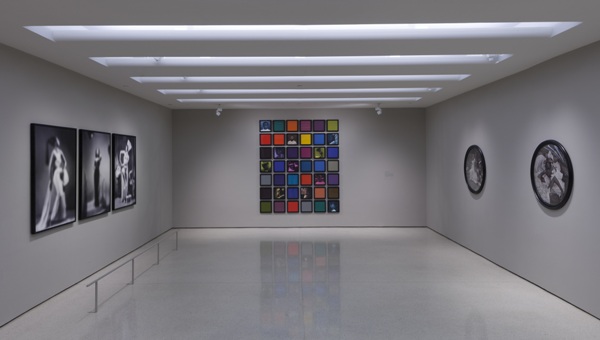Art & Exhibitions
Critical Reduction: Carrie Mae Weems at the Guggenheim
What the critics had to say about the Carrie Mae Weems retrospective at the Guggenheim.

What the critics had to say about the Carrie Mae Weems retrospective at the Guggenheim.

Benjamin Sutton

Introducing Critical Reduction, wherein we do precisely what art critics hate: Distill their reviews into one essential excerpt and accompanying letter grade that we think encapsulates their estimation of the exhibition in question. For this inaugural edition, we look at recent reviews of “Carrie Mae Weems: Three Decades of Photography and Video” at the Guggenheim in New York.

Carrie Mae Weems, still from Afro-Chic (2010).
Photo: Courtesy of the artist and Jack Shainman Gallery, New York © Carrie Mae Weems.
The Guggenheim in New York is the final stop for “Carrie Mae Weems: Three Decades of Photography and Video.” The artist’s retrospective debuted at the Frist Center for the Visual Arts in 2012 and has been touring the country ever since, including stops in Cleveland, the Bay Area, and Portland. I’ve culled reviews of the exhibition during its various presentations to get a sense of what the critics thought.
Holland Cotter loves the work, but takes issue with the Guggenheim’s truncated presentation, in the New York Times:
The Guggenheim, with its smallized, to-the-side display of Ms. Weems’s show, edges toward rejecting, even as it appears to be affirming. Instead of a full retrospective, it delivers a career sampler when it has the space and resources to do so much more.
Why didn’t it show, for example, the full “Sea Islands Series” rather than just excerpts? Why, as the last and crowning stop on the exhibition tour, didn’t it add material, fill the survey out, bring in important missing pieces like “The Hampton Project,” Ms. Weems’s haunting 2000 multimedia essay on institutional racism as it applied to both African and Native Americans?
Maybe there were problems with loans, with schedules. Whatever. Where there’s a will there’s a way. It’s a shame.
Cotter gives “Carrie Mae Weems: Three Decades of Photography and Video” a B.
Maika Pollack writes very favorably about the exhibition—particularly Weems’s pre-2000 work—though she worries that the Guggenheim’s curators are continuing to ghettoize the artist, specifically a Black Artist, rather than putting her in dialogue with contemporaries and younger artists. She writes as much in the Observer:
In the 2000s, she takes flight, turning to video and staged self-portraits created during residencies in Rome and Cuba. New air and light enter the dialog. Yet if these works take on increasingly high production values, a gritty, irreverent fun from the early days is gone, replaced with the formal gravitas and poise of an elder stateswoman at work on issues of great importance.
Ms. Weems’ meditations on race, gender and class find an unlikely but welcome home in our self-described “Museum of Non-Objective Painting.” The Guggenheim’s photography curators seem to have the pulse of influential American “identity politics” photographers of the late 20th century, with this show following last year’s survey of cult feminist photographer Francesca Woodman.
Pollack gives “Carrie Mae Weems: Three Decades of Photography and Video” a B+.
Ariella Budick praises Weems’s best-known series, but finds her other works a little heavy-handed, in the Financial Times:
Her least successful works – a black man hoisting a watermelon, for example, or a black woman brandishing a fried chicken leg – tip into stridency. She gets trapped by the clichés she’s trying to dismantle. At other times, her anger dissipates into fuzzy generalities, as in the many self-portraits in which she turns away and gazes over some European beauty spot. At her best, Weems mixes confessional ferocity with clinical coolness, and the combination lifts her beyond crude assertions into the realm of human complexity.
Budick gives “Carrie Mae Weems: Three Decades of Photography and Video” a C+.

Installation view of “Carrie Mae Weems: Three Decades of Photography and Video,” Solomon R. Guggenheim Museum, New York.
Photo: David Heald © Solomon R. Guggenheim Foundation.
Lilly Wei is non-committal but seemingly approving in her review of the Frist Center’s presentation in Art in America:
The show’s selection of around 225 photographs, videos and installations is largely thematic and loosely chronological. Its walkabout format invites viewers to delve, at will, into issues of otherness, race, gender, identity, class, history, migration and place. Weems has a lot on her mind, including the black body and social marginalization. Many of her images are barbed and politically incorrect: for example, the picture of a young black man with an Afro, holding a watermelon, from the series “Ain’t Jokin’” (1987-88). Weems is particularly concerned with black women and how they are portrayed, remembered and forgotten. Her appropriated, softly blurred images of Nina Simone, Josephine Baker, Marian Anderson and others in the series “Slow Fade to Black” (2010) offer a poignant assessment of uncertain celebrity.
Wei gives “Carrie Mae Weems: Three Decades of Photography and Video” a B.
Steven Litt, reviewing the exhibition’s Cleveland presentation, finds it incredibly rich and bold, particularly given the Cleveland Museum of Art’s programming tendencies, as he writes in the Plain Dealer:
The exhibition is enormously refreshing for an institution that has never felt entirely comfortable dealing with art of the present or with difficult subjects that might rattle its audience. That it feels able to share the Weems exhibition with its public is an important sign of institutional growth.
More than that, however, the show is a deeply engaging encounter with an artist whose mission is to challenge the exclusion and marginalization of racial minorities from the world of high art — and from the core narratives of Western history.
Litt gives “Carrie Mae Weems: Three Decades of Photography and Video” an A+.
Robert Taylor, reviewing the exhibition during its stint at Stanford, is calmly praising in the San Jose Mercury News:
Sociologist, cultural anthropologist, folklorist—all these complex descriptions are distilled with incredible subtlety and keen perception in her work. She may be best known for her 1990 “Kitchen Table Series,” images nearly 4 feet square with a narrated story of a woman’s love, loss, motherhood and friendships. Weems is her own subject, and it’s still a powerful, poignant drama.
The juxtapositions and counterpoints in Weems’ work, and in the gallery installations, are remarkable. One wall is nearly filled with photographs of her family, a series begun in the 1970s to counteract reports that the black family was deteriorating. But then, just to the side is an image from her “Ain’t Jokin’ ” series: the stereotyped Aunt Jemima and Uncle Moses salt and pepper shakers on a kitchen counter.
Taylor gives “Carrie Mae Weems: Three Decades of Photography and Video” an A.

Installation view of “Carrie Mae Weems: Three Decades of Photography and Video,” Solomon R. Guggenheim Museum, New York.
Photo: David Heald © Solomon R. Guggenheim Foundation.
Kenneth Baker, covering the exhibition during its Stanford presentation, frames it in relation to the government shutdown of October 2013 in his review for the San Francisco Chronicle:
A few weeks ago, long after the show’s planning, extreme right-wing legislators forced a federal government shutdown under the nation’s first African American president. They even threatened to upend the global economy through a debt default in a bid to undo the Affordable Care Act, the president’s signature social program. Whether such political aggression might give cover to bigotry toward the executive, in a nation that believes it has outgrown racism, is just the sort of issue that Weems’ work tacitly investigates and protests.
With photographs and the mingling of pictures and text that conceptual art licensed around the turn of the 1970s, Weems, who last month received a mid-six-figure “genius grant” from the MacArthur Foundation—a prestigious award almost comparable to the Nobel Prize—probes various dimensions of racial awareness. Rather than challenge the concept of race, she exposes various uses of it as a pretext that people use to justify belittling and abuse of one another or of themselves.
Baker gives “Carrie Mae Weems: Three Decades of Photography and Video” a B+.
The Critical Reduction Super Grade for “Carrie Mae Weems: Three Decades of Photography and Video,” which continues at the Guggenheim in New York through May 14, is a B+.
A Note on Methodology: To arrive at the final Critical Reduction Super Grade, the grade for each critic is converted to a number from 1 to 5; an A is worth 5, a B is worth 4, a C is worth 3, a D is worth 2, and an F is worth 1, with pluses and minuses counting as .5 more or .5 less. Those numbers are summed and divided by the number of reviews being considered (in this case, seven). The resulting total is rounded up or down to the closest whole or half number (in this case, 4.5) and assigned the corresponding letter grade.

Installation view of “Carrie Mae Weems: Three Decades of Photography and Video,” Solomon R. Guggenheim Museum, New York.
Photo: David Heald © Solomon R. Guggenheim Foundation.